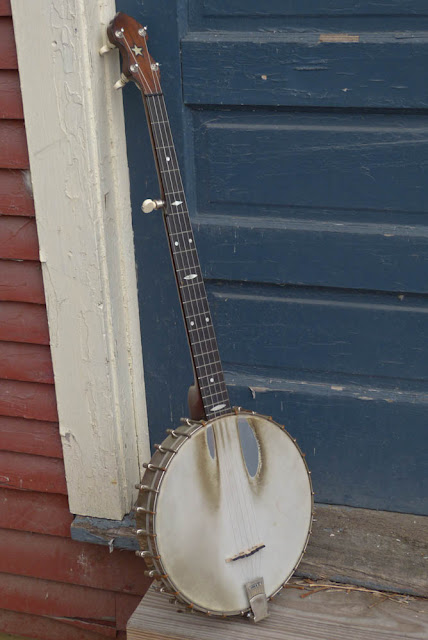1906 Fairbanks No. 4 Special 5-String Banjo
Specifications-wise, this 1906 Fairbanks is a lot like this 1921 Vega. By that I mean the 12" rim, neck shape and feel, and quite-long 28" scale -- features that are both very interesting and desirable. The rest is different, however: this one has the spunover-style pot that was typical for the time and a plainer look. It also shares the extra-rugged and quality build that Vegas (Fairbanks and Vega were the same company by this time) are known for. Once you dial these banjos in, they more or less stay put.
I worked on this one for a customer of mine and gave it a fret level/dress, setup, new bridge, and installed a set of new Waverly 4:1 geared pegs. It's now "hot to trot" and has an excellent, full tone -- and strung with 9s. This one isn't owned by the same fellow who had the Cole/Stratton in the shop, but the head's definitely worn in the same way.
The pearwood headstock veneer has cracked and chipped-out here and there -- something that I find happening a lot with the material. I blame it on the stain used to "ebonize" it.
Fortunately I managed to work around the chip-outs when expanding the shaft-holes for the tuners: when I install these I usually use a reamer rather than a drill as it lets me adjust and feel how I'm cutting it.
These nice, elegant, and simple inlay styles remained on Vega banjos for many years.
Amazingly, the neck on this banjo was pretty-much dead straight, too -- so setup was a breeze.
Note the 5th string "capo" that was installed in the past. It actually works quite well, but the screw-style means you can only have one of them! I think it's sort of a happy accident that between the regular "pip" which is higher than the frets and the "bend" of the string under that screw, the note actually pitches-up near-correct for that fret. Strangely it's on #4 which means -- a B note!
While the hooks/nuts are all-original, that tailpiece is very 70s. I think it's a bit nice to be able to fine-tune the tone with it, though. I also added the new, compensated, 5/8" bridge.
The neck is actually dark-stained maple. This is quite hard, quartersawn stuff.
There's a curled-over edge on the top side of the rim, as well, with a brass hoop inside it. This makes an integral "tonering."
The serial number places it at 1906. Note the use of that nice "Vega-style" neck brace. On this one it looks like there never was a metal plate to protect the rim from the screw's tension (and thus also, as the rim's inside wears, the tension slacking-off and the neck getting loose). I quickly cut a piece of scrap steel to make one for it.
My one best piece of advice for banjo players? Snug up the neck brace every 6 months -- you'll notice that as the weather changes slightly it will get looser or tighter. This, of course, impacts action. A lot of people don't know how temperamental old banjos are -- but if you know how to maintain them -- they're not such cruel beasts. Blog readers will know that I often replace shim-style neck braces with drywall screws on cheaper old banjos... which saves some of this trouble.
This is an impressive-looking piece of gear in person, what with the long neck and oversize rim.



















Comments